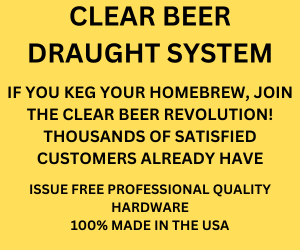Mr. Wizard’s Guide to Cleaning Your Draft System
Q: Two years ago, I bought my first two Corny kegs and have been serving some of my beer on draft (still bottle some). For a while I was just using picnic taps as they were cheap and easy, but I just bought two stainless faucets and will be running them through the fridge door. With the picnic taps, cleaning was easy as I just unscrewed the top piece on both the tap and the quick connect and soaked in cleaner solution followed by a quick sanitizer rinse. I would do this just before putting every new beer on tap. What’s your recommended procedure for cleaning lines and faucets? Do you recommend replacing the tubing over time?
— Frank Petrignani • Brampton, Ontario
A: Clean draft lines and faucets are key to any properly maintained draft beer system. The good news for the homebrewer is that our draft lines tend to be relatively short and contain little volume. For example, 6 feet (1.8 m) of 3⁄16-inch inside diameter line, a typical length in a balanced system designed for normally carbonated beer, contains about 1 ounce (30 mL) of beer. The usual cleaning period in bars is bi-weekly, so even if a keg is on tap for 8 weeks, bi-weekly cleaning at home will consume only 3 ounces (90 mL) of beer.

The most common and simplest method used to clean draft lines in a bar is to use a keg-cleaning bottle to push rinse water and line cleaner through beer lines using gas pressure. This same basic setup can also be purchased with a hand pump. These work great for cleaning multiple short lines in quick succession. It’s typical to fill the bottle with warm water and flush beer from the lines being cleaned. After rinsing, the bottle is then filled with a cleaner and the lines are flushed with cleaner. When multiple lines are cleaned in succession, the cleaner sits in the lines for as long as it takes to flush all lines. Good practice allows adequate soak time between steps to ensure enough time for cleaning. This time varies by cleaner type and what sort of beer has been in the line; 5–10 minutes is generally adequate.
Primary cleaning is sometimes followed by a rinse with a secondary cleaner, usually an acid, or just a thorough rinse with water. This general method cleans the keg coupler/tap, beer line, shank that goes through the cooler/refrigerator wall, and the main contact surfaces of the beer faucet. Not all faucets are cleaned by simply flushing and should be routinely disassembled and cleaned.
Although the method described above is handy for use in bars, it is not the easiest thing to apply at home because keg-cleaning bottles are designed for commercial keg couplers. A spare Corny keg can be used at home, but one of these gems is probably not just sitting around. And if one is the method is probably more trouble than it’s worth.
. . . 6 feet (1.8 m) of 3⁄16-inch inside diameter line, a typical length in a balanced system designed for normally carbonated beer, contains about 1 ounce (30 mL) of beer.
My suggestion for those using Corny kegs is to set up one side of the line with a swivel fitting to allow easy removal from the outlet coupler on your keg. On the other end use a 3⁄16-inch barbed fitting x beer nut coupler to connect your line to the shank that goes through the refrigerator door. When it comes time to clean your line(s), simply disconnect the beer coupler for your keg, unscrew the male beer nut from the beer shank. Next, unscrew the flat nut that connects the shank to the refrigerator door and pull this out from the front of your refrigerator. You can now easily rinse your Corny fitting, beer line, shank, and faucet, clean with an appropriate detergent (soaking in a mild alkaline cleaner like PBW works well), rinse, and reassemble.
You asked about tubing life; well-maintained beer tubing will last for years. The signs that tubing needs to be replaced include visible cracks, soils that do not appear to remove with normal cleaning (assuming tube is clear), difficulty pouring beer, and excessive age. Because homebrew draft lines are typically short and limited in number, replacing is not expensive. Consider noting the installation date of new draft lines and replacing every two years or so. Whatever time is spent cleaning and maintaining draft lines pales in comparison to the time required for bottling. Here’s to draft homebrew!



